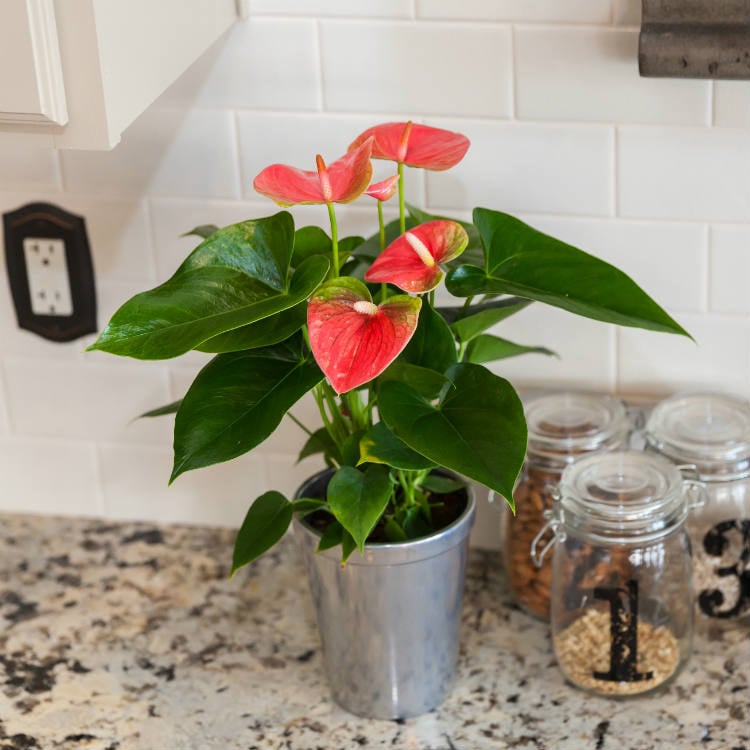
It can be an alarming occurrence for any novice anthurium plant owner — suddenly, the once lush and beautiful heart-shaped leaves on your anthurium have started to wilt and die. Your first thought might be what you did wrong. Your second thought might be wondering whether your anthurium plant is dead for good. Don’t panic! What you’re seeing is a very normal part of the anthurium lifecycle. Sometimes known as the “flamingo flower” for their bright colors, anthuriums are native to tropical environments. While they are often referred to as one of the world’s longest-blooming plants, like many others, they do need to drop blooms and regrow at some point.
The first way to know what the cause of bloom loss is to take a look at your plant all around.
How do the leaves look? How do the roots look? Have you underwatered or overwatered? Too much sun or not enough? Many factors will help you understand your plant’s health.
When properly cared for, anthuriums can bloom year-round, with each bloom lasting between two and three months. By mimicking the conditions of their natural rainforest habitat, your anthurium could produce up to six blooms per year. If you notice a bloom starting to die, you can carefully remove it or pinch it off with your fingers. This allows nutrients to be better shared by the healthy remaining blooms. As your anthurium plant goes through its lifecycle, there are things you can do to help your plant thrive. Follow these steps for the best anthurium plant health and the best chances of reblooming.
1. Ideal anthurium light requirements. Ideally, you want your anthurium to be in a brightly lit, warm room that receives enough air circulation but no major drafts.
If you don’t want your anthurium plant in direct sunlight, keep it near a window so it can receive plenty of bright, indirect light. If your anthurium receives too much light, you could burn or scorch the leaves. If it doesn’t get enough light, it could wilt.
2. Proper anthurium temperature range. For most modern homes with central air and heating, this isn’t a problem. However, it is important to ensure your anthurium isn’t positioned near an outside door or vent since drafts could lower the immediate temperature. Instead, anthuriums grow best when the temperature is kept between 70- and 85 degrees Fahrenheit. If you have to move your plant to different areas of your home in different seasons, that’s okay too! Humidity is also a bonus for your plant, as it mimics its natural environment.
3. Water your anthurium properly. One of the biggest risks to your anthurium’s health is root rot from improper watering. Oversaturating an anthurium plant, or not giving them enough water, can both cause health problems that could lead to the death of the plants if you don’t take quick action. To avoid this problem, give your anthurium six ice cubes or one-half cup of water per week.
4. Prune anthurium flowers as they wilt. When you notice a flower on your anthurium is past its prime, your best bet is to safely remove it. This allows your plant to dedicate more energy to developing new blooms, rather than keeping failing blooms alive longer.
Since anthuriums won’t rebloom on the same stalk, you can remove any wilted flowers by pruning the entire stalk off at the base of the plant. Just make sure you use clean, sterilized cutting shears to avoid spreading disease to your plant.
5. Remove brown and dead leaves. Generally, brown leaves aren’t anything to be alarmed about and can simply be removed when you prune wilted blooms. In most cases, brown leaves can be removed by gently tugging with your hands; however, you may need to use cutting shears if they won’t detach easily. If you notice your anthurium plant has consistent brown leaves that occur outside the natural lifecycle of your plant, you may need to switch up your care routine.
6. Repot your anthurium. Anthuriums need to be repotted every two to three years, or once they've outgrown their current pot. You do not have to repot your anthurium when you bring it home. When your anthurium has grown to 20 inches tall in a pot with a five-inch diameter, it's time to upgrade it to a new pot.
Now that you’ve given your anthuriums the care they need to thrive, it’s only a matter of time before a new bloom will appear to delight you.

Copyright Just Add Ice® Orchids 2023